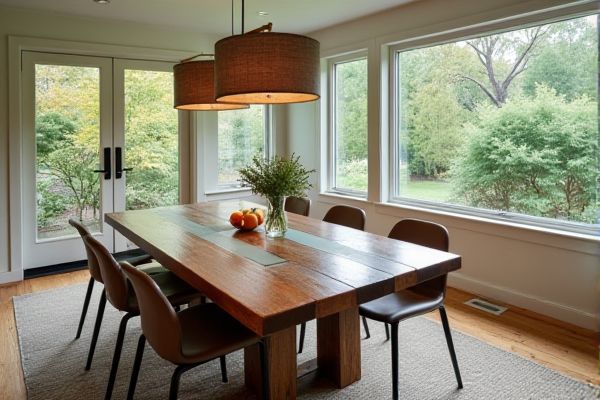
A reclaimed wood table brings warmth and rustic charm to your sunroom, offering durability and unique character from its natural imperfections, while a glass top table creates a sleek, modern aesthetic with easy maintenance and an airy feel by reflecting light. Explore the rest of the article to discover which option best suits your sunroom style and practical needs.
Table of Comparison
| Feature | Reclaimed Wood Table | Glass Top Table |
|---|---|---|
| Material | Recycled hardwood, eco-friendly | Tempered glass, metal or wood frame |
| Durability | Strong, natural wear over time | Scratch-resistant but can chip or crack |
| Maintenance | Requires periodic sealing and cleaning | Easy to clean with glass cleaner |
| Style | Rustic, warm, vintage appeal | Modern, sleek, airy look |
| Weight | Heavy | Light to moderate weight |
| Suitability for Sunroom | Natural wood complements sunlit space | Enhances brightness and openness |
| Environmental Impact | Eco-friendly, repurposed materials | Manufacturing has higher energy use |
| Price Range | Moderate to high depending on wood quality | Varies; often affordable to premium |
Introduction to Sunroom Table Choices
Reclaimed wood tables bring warmth, character, and sustainability to sunrooms, offering natural textures that complement the bright, airy space. Glass top tables enhance the open feel with their sleek, modern look and unobstructed light flow, making them ideal for smaller sunrooms. Choosing between reclaimed wood and glass depends on balancing rustic charm with contemporary elegance and considering maintenance needs under sun exposure.
Aesthetic Appeal: Reclaimed Wood vs Glass Top
Reclaimed wood tables bring a warm, rustic charm with natural grain variations and rich textures that create a cozy, inviting sunroom atmosphere. Glass top tables offer a sleek, modern aesthetic that enhances light reflection and opens visual space, making your sunroom appear brighter and more spacious. Choosing between the two depends on whether you prefer organic, tactile warmth or clean, contemporary elegance for your space.
Durability and Longevity Comparison
Reclaimed wood tables exhibit exceptional durability due to their dense, seasoned timber, often sourced from old-growth forests, making them resistant to wear and environmental changes in a sunroom setting. Glass top tables, while visually sleek and easy to clean, are prone to scratches, cracks, and potential damage from fluctuating temperatures and direct sunlight exposure. The longevity of reclaimed wood surpasses glass, as wood can be refinished and repaired over time, whereas glass requires complete replacement if damaged.
Maintenance and Cleaning Demands
Reclaimed wood tables require regular dusting and occasional treatment with wood-specific oils or sealants to prevent warping and maintain their rustic charm, while glass top tables demand frequent cleaning to remove fingerprints and smudges using glass cleaners for a sparkling finish. Your sunroom environment, exposed to sunlight and humidity, can affect reclaimed wood more, necessitating vigilant upkeep to avoid discoloration or cracking. Glass tops offer a low-maintenance, easy-to-clean surface but may show streaks and require gentle handling to prevent scratches.
Eco-Friendliness and Sustainability
Reclaimed wood tables offer superior eco-friendliness by repurposing existing materials, reducing the demand for new lumber, and minimizing deforestation. Glass top tables, while recyclable, typically involve energy-intensive production processes and raw material extraction. Choosing reclaimed wood supports sustainability by promoting resource conservation and lowering the carbon footprint associated with furniture manufacturing.
Cost Considerations and Value
Reclaimed wood tables typically offer a higher upfront cost due to their handcrafted nature and sustainable sourcing, but they deliver long-term value with durability and timeless appeal in your sunroom. Glass top tables tend to be more affordable initially but may require frequent maintenance and replacement, potentially increasing overall expenses. Choosing a reclaimed wood table enhances your sunroom's aesthetic and resale value, providing a cost-effective investment over time.
Light Reflection and Room Brightness
Reclaimed wood tables absorb more light due to their textured, matte surfaces, creating a warm, cozy atmosphere but reducing overall room brightness in a sunroom. Glass top tables reflect natural sunlight, enhancing light distribution and making the space feel larger and airier. Choosing a glass top maximizes illumination and accentuates brightness, while reclaimed wood adds character with a softer, subdued light effect.
Comfort and Practicality for Daily Use
Reclaimed wood tables offer warm, tactile comfort and durability ideal for daily sunroom use, with natural textures that resist scratches and hide wear over time. Glass top tables provide a sleek, modern aesthetic and are easy to clean but may feel colder and show fingerprints and smudges more readily, requiring frequent upkeep. Your choice balances cozy practicality with minimalist maintenance depending on your sunroom's atmosphere and daily demands.
Versatility in Décor Styles
Reclaimed wood tables offer a rustic charm with timeless appeal, seamlessly blending into farmhouse, industrial, or bohemian sunroom aesthetics. Glass top tables provide a modern, sleek look that enhances light flow and complements minimalist, contemporary, or coastal decor themes. Choosing between the two depends on whether the goal is to highlight natural textures and warmth or to emphasize openness and clean lines in the sunroom space.
Final Verdict: Which Table Suits Your Sunroom?
Reclaimed wood tables bring warmth, natural texture, and durability, enhancing a sunroom with rustic charm and sustainable appeal, while glass top tables offer sleek, modern aesthetics and easy maintenance, maximizing light flow and creating an airy atmosphere. Choosing between them depends on your sunroom's design theme and functional needs--opt for reclaimed wood to add character and sturdiness or glass top for a minimalist, bright space. Both options complement sunrooms differently, making final decisions hinge on whether you prioritize organic warmth or contemporary elegance.
 homyna.com
homyna.com